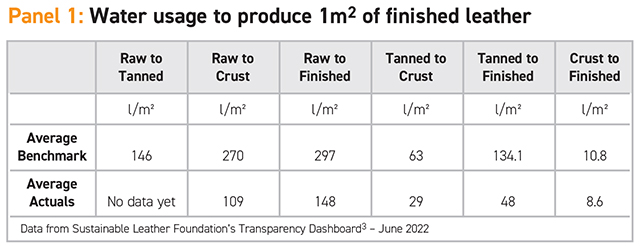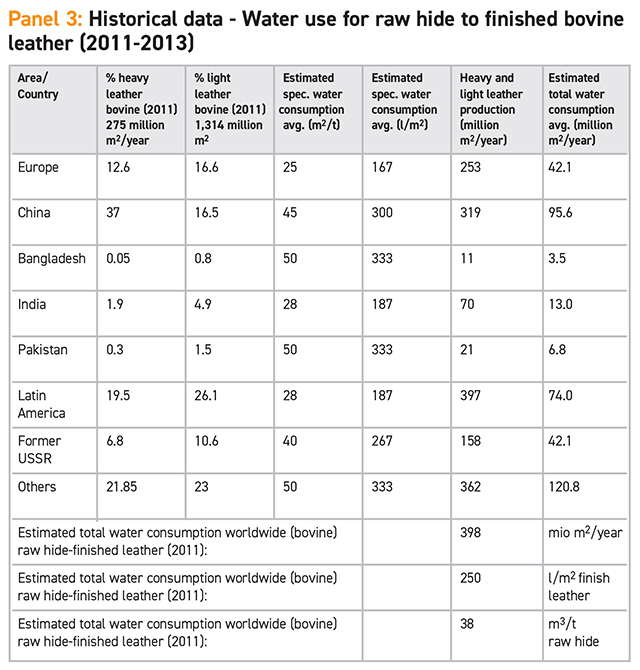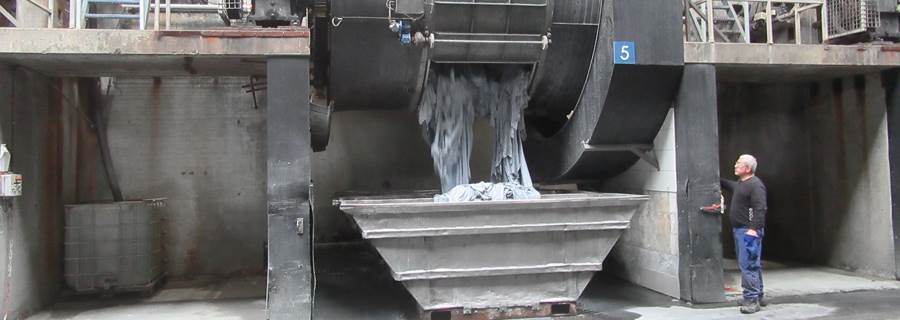Essay ten: Management of water-use in tanneries
Reducing water use in tanneries
This essay seeks to explain how far the leather industry has come in terms of water reduction in recent years. The original version, which industry consultant Jutta Knoedler contributed to the Nothing To Hide series, first appeared in World Leather, August-September 2015. Much of the original data remains current but we have worked with the founder of the Sustainable Leather Foundation, Deborah Taylor, to update as much of the information as possible.A natural resource, water is essential for life. Responsible consumption of water is a key priority for ensuring that an adequate, safe, clean supply is available for health, the environment and industry. Finding new and innovative ways to reduce pollution loads in industrial wastewater, improving the cleaning and treatment of wastewater to enable more recycling, and reducing the amount of water that is used to begin with, are all necessary components for future social and economic development within a more sustainable model.
According to UN-Water1, it is estimated that, globally, more than 80% of wastewater is released into the environment without adequate treatment. By the 2020s, the annual amount of water used across all sectors was approximately 4,600,000 million m3; 69% used in agriculture, 19% in industry and 12% in domestic use (UN/FAQ/Aquastat). Experts estimate that by 2050 total water consumption will rise by between 20% and 30% to as much as 6,000,000 million m3.
As stated in the original Nothing To Hide essay ten from Jutta Knoedler, the tanning industry is one of the main industries with a high-water consumption. This century-old statement can be read in nearly every thesis about water usage in tanneries. But does this indicate the industry has done nothing over the past few decades to reduce the amount of water it uses?
The leather value chain uses water at many stages of production and the amount used depends upon the type of tanning method adopted. For many years, leather technologists and experts have looked at ways to minimise the amount of water used, while at the same time finding better methods of treatment and recycling.
Water use is linked to other sustainability risks within leather manufacturing, such as use of chemicals and water pollution. If the amount of water used in the tanning process is reduced, you can also reduce the amount of chemicals that are needed and this, in turn, will reduce the amount of residual chemicals and pollutants to be treated. Wastewater treatment is a key priority for the industry for two reasons: first so that any wastewater returned to the environment is free from harmful chemicals and other pollutants and, second, so that there is the opportunity for recycling the same water back into tannery production or for irrigation use.
The leather industry has been actively working on water use minimisation for many years, however, up-to-date figures are not readily available. Where figures are available, The Sustainable Leather Foundation (SLF) records water usage metrics (alongside other sustainability criteria) and enables accurate, real-time information on trends and outcomes of new technology and process adoption. Using a benchmark average based on Leather Working Group award bandings, the only available data set that the industry had been assessed against previously2, SLF took the bronze bandings (as per July 2021) for the various categories of leather manufacture to provide a consistent starting point with current industry norms.
While SLF’s ‘Transparency Dashboard’ is still only one year old at the time of publishing this update, it already lists 27 tanneries and of those 27, the water usage data has consistently fallen well under the average benchmark that is being used currently3.

Although the sample size is small, the range of facilities has a geographic spread that includes Argentina, Bangladesh, Brazil, Germany, India, Italy, Pakistan and Turkey and no single facility recorded a consumption level higher than the average benchmark data.
This data is also backed up by recent publications by the Italian national tanning industry association, UNIC, and the representative body of the European Leather Industry, COTANCE. In its 2021 sustainability report, UNIC reported that since 2003, water consumption among Italy’s leather manufacturing companies had dropped by 18% and that on average, 113 litres of water was required to produce one square-metre of finished leather. Similarly, in its Social and Environmental Report 2020, COTANCE reported that between 2016-2018, European tanneries consumed an average of 0.121 cubic metres (121 litres) of water to produce one square-metre of finished leather; this was 7% less than the average amount reported for the years 2010 and 2011.
Signs of hope
The huge global water use figure does not mean that the world is running out of water, but critically, water is not always available when and where it is needed. Therefore, different areas have different regulations. A high proportion of leather production is still located in developing or low- and middle-income areas such as China, India and Latin America. It is assumed that the water consumption here is higher than in developed areas, but improvements are being evidenced. From the 2011-2013 data, the weighted average of the water amount with specific consumption data for bovine tanneries (raw hide to finished leather) was calculated to be approximately 250 litres per square-metre of finished leather. What this indicates is that current water consumption is far less than it was a decade ago when the last meaningful statistics were published and this demonstrates the efficacy of the improvement and development that leather manufacturers are working on, both in process and also in recovery methods.
The tanning industry has a complex structure in terms of materials, processes, and manufacturing practices. Therefore, every tannery must develop a management system adapted to its specific needs in terms of production and location. However, some general solutions can still be reviewed by every tannery and recommendations should be applied in the ‘reduce, reuse, recycle’ model.

- Measure and monitor water use in inflow, effluent, different production areas and equipment
- Understand, calculate, and benchmark the water footprint of the tannery
- Use water-efficient production processes such as low float-length (for example use 85% instead of 100%) and fewer washing processes
- Use of fresh hides, which reduces the need to remove salt and improves wastewater
- Install water-efficient machines (good-quality drums and machines for splitting, samming)
- Investigate technology-driven improvements (see Panel 2)
- Use high-pressure cleaners and cleaning machines for floors, drums and equipment
- Reuse and recycle water, for instance washing water, cooling water, split-flow water
– Reuse water and chemicals (such as sulfides and lime in liming splits)
– Split-flow water reuse, instead of recycling final treated mixed water
– Have a material-overlapping view for innovative and sustainable treatment technologies for water reuse and recycling; use methods with low energy consumption, low chemical use, less sludge and lower air emissions (not all water recycling methods are sustainable). - Consider active content in liquid products and optimise chemical consumption (no overdosing), use biodegradable chemicals.
There are excellent reasons for tanners to reduce water consumption: as part of their own quest for sustainable production, to meet legal directives, cleaner production demands and customer requirements, or to reduce costs.

As more facilities measure, understand and register their data through auditing platforms, such as SLF, LWG and with regional and global industry bodies, the true data can be evidenced to support the sustainable efforts of the industry. This transparent approach will also enable brands, retailers and campaign organisations to deliver credible, consumer-facing information that can be evidenced.
References:
1. https://www.unwater.org/
2. www.leatherworkinggroup.com
3. https://sustainableleatherfoundation.com
Photo: Ecco Dritan process - The technology was the fruit of five years’ research and development activity, which had as its starting point a question about the possibility of tanning without water in a world of increasing water scarcity.




